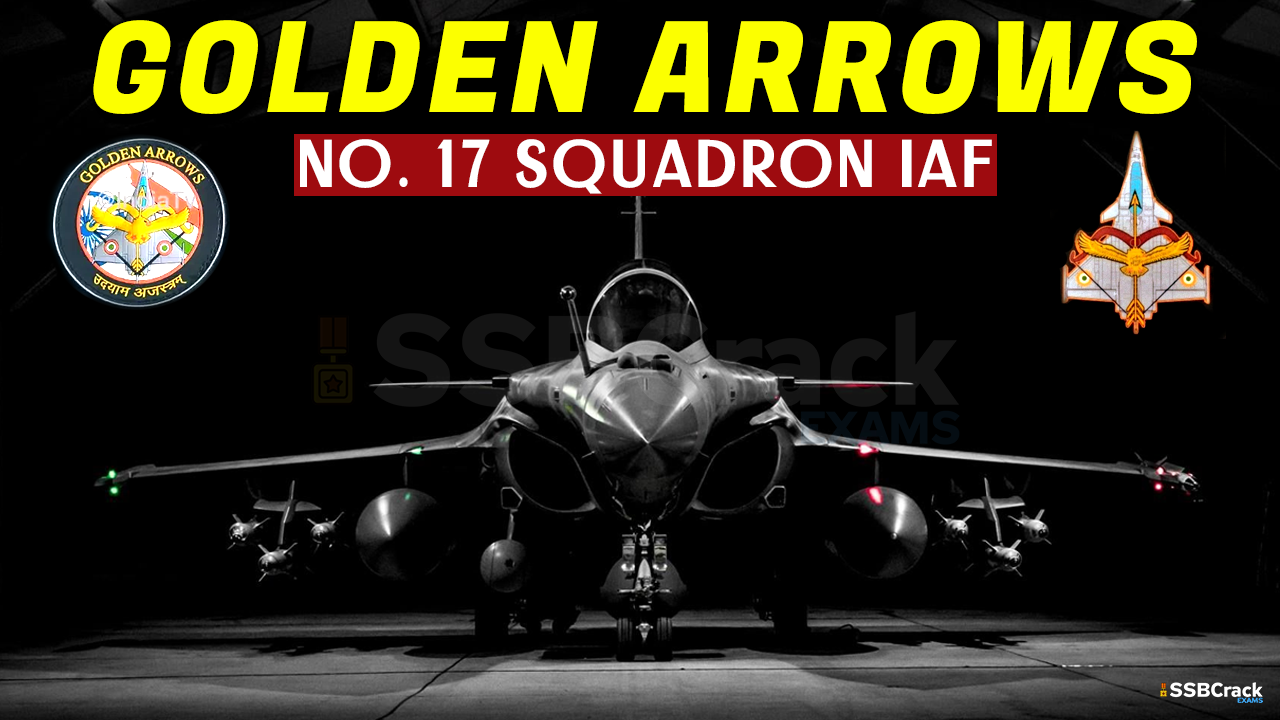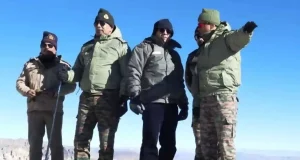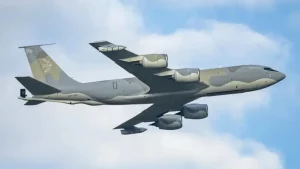The MMRCA Competition
- The Medium Multi-Role Combat Aircraft (MMRCA) competition in India, also known as the MRCA tender, was a competition to supply 126 multi-role combat aircraft to the Indian Air Force (IAF) in 2014.
- The Defence Ministry had allocated ₹55,000 crore (US$7.7 billion) at 2008 prices for the purchase of these aircraft, making it India’s single largest defence deal.
- The contest featured six fighter aircraft:
- Boeing F/A-18E/F Super Hornet
- Dassault Rafale
- Eurofighter Typhoon
- Lockheed Martin F-16 Fighting Falcon
- Mikoyan MiG-35
- Saab JAS 39 Gripen
- Among these, Dassault Rafale won the competition.
- Due to various allegations on the deal, on 13 April 2015, the then Defence Minister Manohar Parrikar made an announcement that the MMRCA tender is “effectively dead”. India officially withdrew the 126-aircraft MMRCA tender on 30 July 2015.
Modi’s Intervention
- On the joint press statement made by Prime Minister Narendra Modi’s with the then French President François Hollande, during his visit of France, the PM said that India will purchase 36 Rafales. This contract was finalised and all the 36 aircraft will arrive in India in flying condition. Out of these 36, 30 will be fighter aircraft and 6 will be trainers.
- The agreed upon terms in April 2015 totaled US$8 billion for 36 airplanes costing $200 million each, with an offset requirement of 30 percent of the deal’s value for France to reinvest in India’s defense sector and create infrastructure in India for the Rafale to operate. The current French President Emmanuel Macron and the Indian Ambassador to France Jawed Ashraf are expediting this deal carefully.
Naval Variant – May Be……
- In January 2016, the Indian government directed the Indian Navy to undertake detailed briefings with Dassault regarding the Rafale, in a potential start to procurement of the naval version for its aircraft carriers. The government wants commonalities between logistics and spares for fighters with the Navy and Air Force, which could lead to a buy of 54 naval fighters.
The Dassault Rafale
- Rafale is a twin-engine medium multi-role combat aircraft, manufactured by French company Dassault Aviation. Dassault claims Rafale has ‘Omnirole’ capability to perform several actions at the same time, such as firing air-to-air missiles at a very low altitude, air-to-ground, and interceptions during the same sortie.
- The aircraft is fitted with an on-board oxygen generation system (OBOGS) which suppresses the need for liquid oxygen re-filling or ground support for oxygen production.
- It carry out a wide range of missions: Air-defence/air-superiority, Reconnaissance, close air support dynamic targeting, Air-to-ground precision strike/interdiction, anti-ship attacks, nuclear deterrence, buddy-buddy refueling.
- The induction of the Rafale fighter jet will be a “game changer” for India in regional geopolitics of South Asia in so far as Pakistan and China are concerned.
- A delta wing with active close-coupled canard to maximize manoeuvrability.
- Extreme G-limits: −3.6g to 9g
- The Rafale is an aerodynamically unstable aircraft and uses digital fly-by-wire flight controls to artificially enforce and maintain stability.
- Seventy percent of the Rafale’s surface area is composite.
- Rafale’s visibility to threats remain classified.
- The Rafale core avionics systems employ an integrated modular avionics (IMA), called MDPU (modular data processing unit). This architecture hosts all the main aircraft functions such as the flight management system, data fusion, fire control, and the man-machine interface.
Armament:
- The MICA air-to-air “Beyond Visual Range” (BVR) interception, combat and self-defense missiles, in their IR (heat-seeking) and EM (active radar homing) The MICA can be used within visual range (WVR) and beyond visual range (BVR).
- The METEOR very long-range air-to-air missile, The METEOR very long-range rocket and ram-jet powered air-to-air EM missile. Its combination with the Rafale weapon system is a real paradigm change in air to air affairs.
- The HAMMER (standing for Highly Agile and Manoeuvrable Munition Extended Range) modular, rocket-boosted air-to-ground precision guided weapon series, fitted with INS/GPS or INS/GPS/IIR (imaging infra-red) guidance kits, or with the upcoming INS/GPS/laser guidance
- The SCALP long-range stand-off missile,
- The AM39 EXOCET anti-ship missile,
- Laser-guided bombs with different warheads from 500lbs to 2,000 lbs
- Classic bombs non guided
- The 2500 rounds/min NEXTER 30M791 30 mm internal cannon, available on both single and two-seaters
- Specifics armaments selected by India.
Engines:
- The Rafale is fitted with two Snecma M88 engines, each capable of providing up to 50 kilonewtons (11,000 pounds-force) of dry thrust and 75 kN (17,000 lbf) with afterburners. The M88 enables the Rafale to supercruise while carrying four missiles and one drop tank.
The News
- Among 36 aircraft, 10 aircraft are delivered to IAF where 5 remain in France for training missions.
- The first batch of five Rafale fighter aircraft (3 single seater and 2 twin seater aircraft) on Monday (27th July 2020) took off from France for India, nearly four years after the two countries inked an inter-governmental agreement to supply 36 of the multi-role jets to the Indian Air Force under Rs 59,000-crore deal.
- The aircraft flew out from the Merignac airbase in French port city of Bordeaux and will cover nearly 7,000 km with air-to-air refueling and a single stop in the United Arab Emirates before arriving at Ambala airbase on Wednesday (29th July 2020).
About the Ambala Air Base
- Nicknamed as “Golden Arrows”, the No. 17 Squadron takes shelter at this air base and it is considered one of the most strategically located bases of the IAF as the Indo-Pak border is around 220 km from it.
- Currently, the base has two squadrons of the Jaguar combat aircraft and one squadron of the MiG-21 Bison.
- Marshal of the IAF Arjan Singh was the first commander of the Ambala base in independent India.
About the “Golden Arrows”
- No. 17 Squadron is a squadron of the Indian Air Force stationed at Ambala AFS as part of Western Air Command.
- The squadron was disbanded in 2016 but was resurrected in Ambala on 11 September 2019 with Dassault Rafales.
- It was formed on 1 October 1951, and initially flew Harvard-II B. It was moved during the 1965 Indo-Pakistani War to provide air cover for the capital. It was awarded its President’s Standard on 8 November 1988 at Palam.
Rafale + Sukhoi = Deadly Combo
- “Once the Su-30MKI and the Rafale start operating together, it will be a potent combination against our adversaries, be it Pakistan or anybody else. It will be a potent capability. Any adversary would be worried about such a combination,” said the then VCAS RKS Bhadauria during the Garuda-VI exercise of IAF. He was then the chief negotiator of the deal and is now the CAS.
Improving the air superiority
- Official sources said the Rafale jets are likely to be deployed in the Ladakh sector as part of IAF’s efforts to enhance its operational capabilities along Line of Actual Control with China in view of the border row with the country.
- Rafale is intended to perform air supremacy, interdiction, aerial reconnaissance, ground support, in-depth strike, anti-ship strike and nuclear deterrence missions. The Rafale is referred to as an “omnirole” aircraft by Dassault.
- In a statement, the Indian embassy said IAF pilots and supporting personnel have been provided full training on the aircraft and weapon systems by Dassault. Further batches of IAF personnel will continue the training over the next nine months.
- Besides the missile systems, the Rafale jets will come with various India-specific modifications, including Israeli helmet-mounted displays, radar warning receivers, low-band jammers, 10-hour flight data recording, infra-red search and tracking systems among others
- The IAF has already completed preparations, including readying required infrastructure and training of pilots, to welcome the fighter aircraft.
- The second squadron of Rafale will be stationed at Hasimara base in West Bengal. The IAF spent around Rs 400 crore to develop required infrastructure like shelters, hangars and maintenance facilities at the two bases.



















